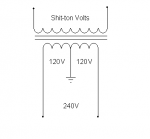GooeyGus
0
- Joined
- Mar 8, 2008
- Messages
- 2,669
- Points
- 48
Now this may seem like a stupid question, and while I know a good amount about lasers I don't claim to be an electrician in any way. I have 240v service to my house for my dryer and stove, but they are very far away from my lasers which run on 240v power. In my room, however, I have two 120v outlets in close proximity which are on two separate breakers. My question is, can I combine two of these outlets (again, on separate breakers) to create 240v to plug a laser into? I realize this could cause some problems if one breaker blew and the other one didn't (although if one blew I think the other would instantly go as well due to the spike in current draw) so its probably not a good idea anyway, I just wanted to see if it is in the realm of possibility at all.






